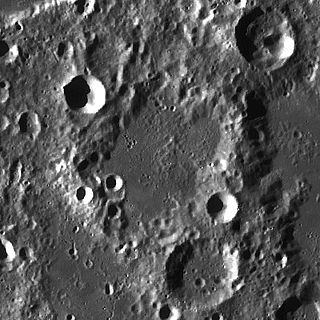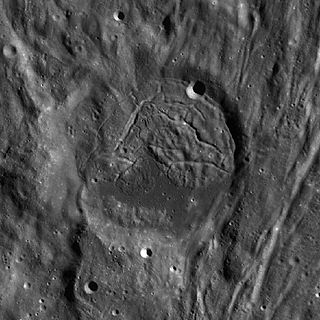
Bianchini is a lunar impact crater that lies along the northern Jura Mountains that ring the Sinus Iridum, in the northwestern part of the near side of the Moon. It was named after Italian astronomer Francesco Bianchini. The impact of this crater near the edge of the Jura Mountains deposited some material into the Sinus Iridum floor.

Abel is an ancient lunar impact crater that lies near the southeast limb of the Moon's near side. It is located to the south of the crater Barnard, at the northwest edge of the Mare Australe.

Archytas is a lunar impact crater that protrudes into the northern edge of Mare Frigoris. To the northwest is the comparably sized crater Timaeus, and the smaller Protagoras lies in the opposite direction to the southeast. Further to the southwest, beyond the opposite edge of the mare, is the dark-floored crater Plato.

Arrhenius is a lunar impact crater that is located just on the far side of the Moon, near the southwest limb. In this location the vicinity of the crater can be viewed during favorable librations, although it is viewed from on edge. To the south-southeast is the worn crater Blanchard, and De Roy lies further to the west.

Artem'ev is a lunar impact crater that is located on the far side of the Moon. The rim of this crater has been modified by subsequent impacts in the vicinity, with an inward bulge along the southwest edge and a worn impact lying across the north rim. The satellite crater Artem'ev G is partly overlain by the southeast rim of Artem'ev. The crater interior is relatively flat, and marked only by tiny craterlets.

Büsching is a lunar impact crater that is located in the crater-covered southern highlands of the Moon. It was named after German geographer Anton F. Büsching. The similar-sized crater Buch is located adjacent to its southwestern rim, and further to the southwest lies Maurolycus.

Berlage is an old lunar impact crater that lies in the southern hemisphere on the far side of the Moon. The smaller crater Bellinsgauzen is attached to its northern rim, and Cabannes is less than one crater diameter to the northwest. To the east-northeast of Berlage is Lemaître.

Drude is a lunar impact crater that lies on the far side of the Moon, in the rugged Montes Cordillera range that forms the outer ring around the Mare Orientale impact basin. It is located just behind the west-southwest limb, and this area is sometimes brought into sight from Earth during favorable librations. However, even at such times, the crater is viewed from the edge and little detail can be seen.

Freud is a tiny lunar impact crater that lies on a plateau within the Oceanus Procellarum, in the northwest part of the Moon's near side. It is located a few kilometers to the west of the Vallis Schröteri, a large, sinuous valley that begins to the north of the crater Herodotus, then meanders north, then northwest, and finally southwest, until it reaches the edge of the lunar mare.

Demonax is a lunar impact crater near the southern limb of the Moon. This location makes the crater difficult to observe due to foreshortening. The crater is also illuminated at a very low angle, when it is in the sunlit side. Demonax lies just to the north of the crater Scott, one of the south polar formations. To the north-northwest is Boguslawsky.

Cajori is a lunar impact crater that is located in the southern hemisphere on the far side of the Moon. It lies to the southwest of the walled plain Von Kármán, and to the east-southeast of the crater Chrétien.

Chadwick is a lunar impact crater that lies on the far side of the Moon's surface, just beyond the southwestern limb. It is located to the northwest of the crater De Roy, and was previously designated De Roy X before being given its current name by the IAU. This region of the lunar surface lies at the southern end of the ejecta blanket that surrounds the Mare Orientale impact basin.

Coriolis is a lunar impact crater that is located on the far side of the Moon. The crater floor is bisected by the lunar equator, and it lies about three crater diameters northwest of the crater Daedalus.

Congreve is a lunar impact crater that is located on the far side of the Moon relative to the Earth, and lies across the lunar equator. It lies to the west-northwest of the massive walled plain Korolev. To the southeast is the crater Icarus, and due north is Zhukovskiy.

Dziewulski is a lunar impact crater on the far side of the Moon. It lies between the craters Edison to the north and Popov to the south. The outer rim of this crater has been considerably worn by impacts, particularly along the southwest quadrant where the satellite crater Dziewulski Q overlies the rim and the interior floor. The northern rim is also heavily disrupted, and several small crater lie along the southeast rim. The interior floor and surrounding terrain has been resurfaced.

Donner is a lunar impact crater on the far side of the Moon. It is located just to the northeast of the Mare Australe, behind the southeastern limb of the Moon. During favorable librations this part of the lunar surface can be brought into view of the Earth, but the site is viewed from the edge and so not much detail can be seen.

Dreyer is the remnant of a lunar impact crater on the far side of the Moon. It is located along the eastern edge of the Mare Marginis, about midway between the craters Ginzel to the north and Erro to the south-southeast. It was named after Danish-Irish astronomer John L. E. Dreyer.
Eijkman is a lunar impact crater that is located on the far side of the Moon's southern hemisphere. It lies about a half crater diameter to the southeast of the larger crater Lemaître. To the south-southwest is the crater Crommelin, and to the northeast is Fizeau.

Espin is a lunar impact crater that lies on the far side of the Moon, just beyond the northeastern limb. It lies to the west-southwest of the larger crater Seyfert, and northwest of Deutsch.

Fényi is a small lunar crater on the far side of the Moon. It lies near the southern edge of the huge, braided skirt of ejecta that surrounds the Orientale impact Basin to the north. Less than two crater diameters to the southwest is the much larger crater Mendel.



























